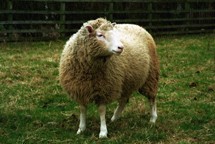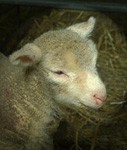
Food Safety Focus (38th Issue, September 2009) – Food Safety Platform
Animal Cloning and Food Safety
Reported by Ms. Shuk-man CHOW, Scientific Officer,
Risk Assessment Section, Centre for Food Safety
After discussing the safety concerns over the use of genetic engineering for food production in previous issues, we are going to start a new topic on another new biotechnology - animal cloning*.


Illustration: Dolly - the world's first cloned mammal
[ Source: Roslin Institute and Royal (Dick) School of Veterinary Studies of the University of Edinburgh ]
Animal Cloning
Different from genetic engineering which involves the modification of an organism's genetic make-up, animal cloning is the technology of producing a genetically identical copy of an animal without any intentional changes in the genetic materials. The world's first cloned mammal was a sheep named Dolly born in 1996 in Scotland . Since the appearance of Dolly, a number of other animals such as cattle, pigs, goats, cats and dogs were also cloned.
Why Are Animals Cloned?
Conventional breeding and other techniques assisting reproduction have been used for some time to improve the quality of domestic animals. However, conventional breeding is relatively time-consuming and limited in that desirable traits may be diminished or diluted out in subsequent generations. Cloning, however, allows the reproduction of animals that have all the desired genetic characteristics of the parent. Cloning can also help farmers to preserve rare and endangered varieties with desired traits but poor fertility. These allow farmers to upgrade the quality of their herds by providing more copies of their best animals.
Concerns over Animal Cloning
Animal health and welfare
In general, animal cloning is relatively inefficient and a large proportion of clones will result in pre-natal difficulties. Cloned animals also tend to have more health problems at birth and may be more likely to die right after birth. Even the clones survive, they are found to have a shorter life span than their non-clone counterparts.
Food safety
In addition, changes in gene expression, which may be introduced during the cloning process, may lead to a difference between the composition of food products derived from cloned animals and that derived from the ordinary animals.
Safety Assessment of Food Derived from Cloned Animals and Their Offspring
Recently, safety of food derived from cloned animals and their offspring has been evaluated by a number of national/regional authorities based upon peer-reviewed scientific data. In general, there is no evidence that consumption of food products from cloned animals or their offspring pose a greater risk than consumption of products from conventionally bred animals. The U.S. Food and Drug Administration (FDA) has also pointed out that meat and milk from clones of cattle, pigs and goats, and the offspring of clones from any species traditionally consumed as food, are as safe as food from conventionally bred animals.
At this time, cloning an animal is an expensive process and therefore it is unlikely that clones will be used directly as food. Rather, they are used as breeding stock to sexually reproduce offspring which become the food-producing animals. However, just like conventionally farmed animals, cloned animals may enter the food chain one day when their commercially productive lives come to the end.
* Animal cloning is commonly referred to as somatic cell nuclear transfer (SCNT). In SCNT, the nucleus, which contains the genetic material of an animal, is removed from an unfertilised egg and replaced with the nucleus of a body (somatic) cell from the animal to be cloned. After other steps in the laboratory, the embryo is formed and transferred to a surrogate mother where it develops in the womb until birth.


